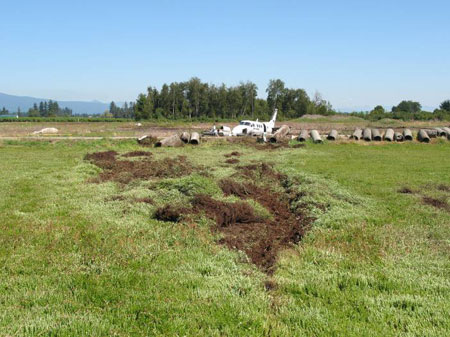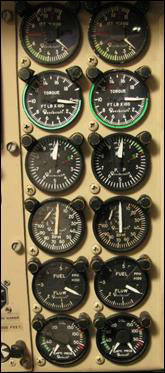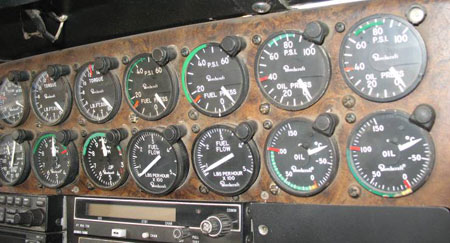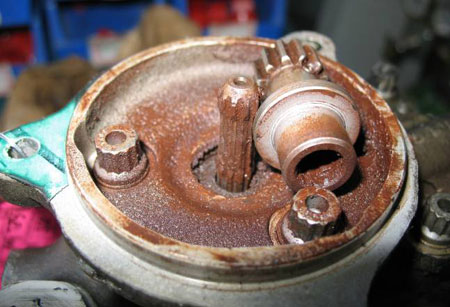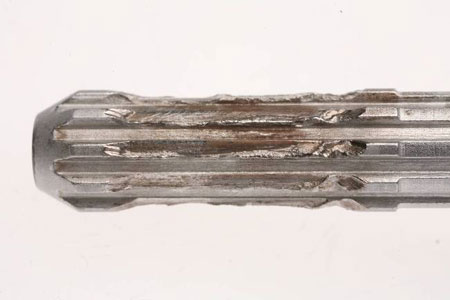Dual-Engine Power Loss – Forced Landing
Bill Dause Beech 65-A90 (King Air) N17SA
Pitt Meadows Airport, British Columbia
The Transportation Safety Board of Canada (TSB) investigated this occurrence for the purpose of advancing transportation safety. It is not the function of the Board to assign fault or determine civil or criminal liability. This report is not created for use in the context of legal, disciplinary or other proceedings. See Ownership and use of content. Masculine pronouns and position titles may be used to signify all genders to comply with the Canadian Transportation Accident Investigation and Safety Board Act (S.C. 1989, c. 3).
Summary
The Bill Dause Beech 65-A90 King Air (United States registration N17SA, aircraft serial number LJ-164) took off from Pitt Meadows Airport, British Columbia, with the pilot and seven parachutists for a local sky diving flight. At 1521 Pacific daylight time, as the aircraft was climbing through 3900 feet above sea level, the pilot reported an engine failure and turned back towards Pitt Meadows Airport for a landing on Runway 08R. The airport could not be reached and a forced landing was carried out in a cranberry field, 400 metres west of the airport. On touchdown, the aircraft struck an earthen berm, bounced, and struck the terrain again. On its second impact, the left wing dug into the soft peat, spinning the aircraft 180 degrees. Four of the parachutists received serious injuries and the aircraft was substantially damaged. There was no fire and the occupants were evacuated. The emergency locator transmitter functioned at impact and was turned off by first responders.
Other Factual Information
History of the Flight
The aircraft was climbing west, away from the Pitt Meadows Airport, at 110 knots when there was a bang. The aircraft shuddered and yawed to the right. The nose was lowered to a level flight attitude, the right engine (a Pratt & Whitney Canada [PWC] PT6A-20) was shut down, and the pilot turned the aircraft left towards Pitt Meadows. The airspeed was indicating 130 knots. The left engine power lever was advanced to maximum, but there was no corresponding rise in torque (power). Left engine torque decreased until all engine power was lost. In an attempt to restart the engines, both engine auto-ignition switches were selected ON. The restart was unsuccessful. The nose was lowered to maintain airspeed, but the airport could not be reached. The aircraft touched down in a flat cranberry field bordered by three-foot-high berms (see Photo 1). On landing, the aircraft struck several of the many concrete irrigation culverts that lay on the edge of the berm. The accident site is located adjacent to the Pitt Meadows Airport at 49°13′15″ N, 122°43′45″ W, at an elevation of about 10 feet above sea level.
Weather
The 1310Footnote 1 Pitt Meadows Airport weather observation indicates that the general meteorological conditions at the time of the accident were suitable for visual flight with a few scattered clouds, westerly wind at about five knots, and no reported turbulence.
Pilot
The pilot was certified and qualified for the flight in accordance with existing regulations. He held valid Canadian and United States airline transport pilot licences and had accumulated about 4800 hours of total flying experience, of which 1290 hours were on the King Air A90. Since March 2000, the pilot had received Beech King Air training numerous times; however, the last training received was in May 2006. He had also attended PWC PT6A pilot familiarization courses in 2000 and 2003. He had flown the accident aircraft for approximately 170 hours.
Weight and Balance
It was calculated that the gross weight of the aircraft at the time of the accident was about 7500 pounds, well within the aircraft's maximum certificated gross take-off weight of 9650 pounds. Calculations also indicated that the centre of gravity was within limits.
Aircraft Information and Operation Approval
The aircraft was manufactured in 1966 by the Beechcraft Aircraft Company.Footnote 2 In April 1996, the aircraft was heavily modified, in accordance with a Federal Aviation Administration (FAA) approval (Form 337 – Major Repair and Alteration), to enable parachuting operations. The passenger seats and seat belts and the door were removed. Seat belts, attached to the floor level seat tracks, were installed. Form 337 stated in part: "...all occupants are required to wear the seat belts under the conditions of FAR part 91.107." Since the modifications, wooden bench seats had been installed. At the time of the accident, the aircraft had accumulated about 13 257 flight hours total time.
Since February 2003, the aircraft had been registered in the United States to Flanagan Enterprises (Nevada) Inc. The aircraft was being operated seasonally in Canada under the Free Trade Agreement (FTA) with a Canadian Foreign Air Operator Certificate-FTA (CFAOC-FTA). The CFAOC-FTA was issued annually by Transport Canada (TC) for parachute jumping operations, recognizing the certificate of authorization issued by the FAA to Bill Dause, the FTA operator of record. At the time of the accident, Pacific Skydivers Ltd. of Pitt Meadows was using the aircraft for revenue parachute jumping activities. The accident pilot was the owner of Flanagan Enterprises (Nevada) Inc. and Pacific Skydivers Ltd.
Airframe
The airframe wreckage was examined and no indication was found of any pre-accident anomaly or malfunction with the flight controls.
Propellers
Each engine was fitted with a Hartzell three-bladed, variable-pitch propeller, model HC-B3TN-3B. Maintenance records show that each unit was certified and maintained in accordance with existing regulations and standards. Tear-down examinations revealed that each propeller had been feathered in flight. The aircraft was not equipped with an automatic feathering feature, so propeller feathering was accomplished manually by the pilot.
Engine Malfunction Identification
The King Air A90 emergency checklist requires that, in the event of an engine failure, the pilot shall apply maximum power, confirm the power loss by reference to engine instrumentation, then shut down the failed engine and feather its propeller.
Recent King Air models have engine instrumentation mounted vertically (see Photo 2). With this layout, engine instrumentation is positioned in two vertical columns with the left engine instruments on the left and right engine instruments on the right. This layout makes identification of engine malfunction intuitive.
While the engine instrumentation on the occurrence King Air was arranged so that the left and right engine dials were grouped by function, the overall arrangement was horizontal (see Photo 3). This horizontal arrangement makes it difficult to readily identify and confirm which engine is malfunctioning.
Fuel Loading, Fuel, and Fuel System
The pilot refueled the aircraft approximately one hour before the accident flight. He added a total of 163 litres of Jet A fuel to the two engine nacelle tanks, which reportedly filled them. The corresponding fuel gauges indicated that both nacelle tanks were full. The occurrence flight was the third flight since refueling. At take-off, both nacelle fuel tank gauges indicated half full. This is consistent with the expected fuel consumption of two previous flights. At the time the engines lost power, the fuel gauges still indicated close to half tanks remaining.
Although the fuel tanks were ruptured and fuel had leaked at the accident site, fuel was found in the nacelle airframe fuel filters and the nacelle tanks each had about 10 litres of fuel remaining. No fuel was found in the main wing tanks. Fuel samples from the nacelle tanks and airframe fuel filter contained large particles of contamination. Upon removal and disassembly of the engines, both engine fuel control/fuel pump filters were found to contain an amount of fuel consistent with normal function; however, this fuel was heavily contaminated. In addition to contamination found in the fuel, both engine nacelle fuel filter bowls were found to be heavily corroded. However, fuel found downstream of the fuel filters, in the fuel control units, was adequate for engine operation. Corrosion was also evident in components of the system visible from the fuel filler opening on the left wing. Laboratory analysis of four fuel samples concluded that the fuel was Jet A, with contaminants in all samples, including hydrated rust and filter fibres. The sources could not be determined.
Engines
The two engines in the aircraft were PWC gas turbo-prop model PT6A-20, serial numbers 21606 (left engine) and 20205 (right engine). Because of their impact damage, the engines could not be run in a test-cell facility. They were shipped to PWC for disassembly, examination, and analysis.
The left engine and its components were torn down, inspected, and tested with a TSB investigator present. The only significant anomaly found was that the high-pressure, engine-driven fuel pump drive splines were worn and corroded beyond the point of failure (see Photo 4 and Photo 5). Without fuel being supplied from the high-pressure fuel pump to the fuel control unit, the engine will shut down immediately.
The right engine and its components were disassembled, inspected, and tested. No faults were found that would explain a loss of power in this engine.
Aircraft Records and Maintenance
A review of the aircraft records indicates that, from 01 April 2006 to 06 March 2008 (approximately 23 months), the aircraft flew 402 hours. PWC Service Bulletin (SB) 1803R2 specifies a maximum time before overhaul (TBO) of 3600 hours. At the time of the occurrence, the left engine had exceeded this TBO; it had accumulated 4435 hours in service since its last overhaul completed in 1999. The right engine had accumulated 2478 hours since its last overhaul. Records also indicate that the manufacturer's Phase 3 and Phase 4 inspections of the airframe and engines were accomplished in Lodi, California, United States, on 06 March 2008 and the aircraft had flown approximately 170 hours since that date.
One of the items listed on the maintenance check sheet required inspection of the high-pressure fuel pump of both engines. It indicated the following: "Engine-driven fuel pump coupling shaft – Inspect for fretting and/or corrosion when replacing outlet filter." While the inspection for the right-hand engine was initialled as completed by the Airframe and Power-Plant (A&P) mechanic, the same item for the left engine was marked as not applicable (N/A). The mechanic was not aware of the procedure in the PWC Maintenance Manual, which details how to inspect the splines in situ using a cotton swab.
Maintenance Program
The aircraft utilization was less than 300 hours annually. It was operated in accordance with FAR 91 regulations, and should have been inspected and maintained in accordance with FAR 91.409(e) and 91.409(f)(3), which states in part: "...and the current inspection program recommended by the manufacturer..."
The operator, Bill Dause, believed that, under FAR 91, the engines could be run on conditionFootnote 3 and that they were not required to perform oil analysis, boroscope inspections, or engine condition trend monitoring and analysis to support this on condition program. PWC SB 1803R2 gives operators options on how to apply for an escalation program to the TBO for the PT6 engine series. It states: "...This SB also provides TBO extension procedures for operators with an average utilization higher than 300 hours/year." Furthermore, SB 1803R2 also states that skydiving operations are not eligible for an escalation program.
Regulatory Oversight
In the TC Aeronautical Information Circular 22/07, titled North American Free Trade Agreement (NAFTA) Advisory, the glossary defines national Civil Aviation Authority (CAA) as follows:
The CAA responsible for the regulatory control of an operator when it applies for operating authority and/or registration in another NAFTA country. The national CAA will normally be the same as the state of registry for the aircraft and will be responsible for the regulatory oversight of aircraft on its register, including but not limited to, maintenance and inspection requirements.
The section General Conditions on CFAOC-FTA Certificate N-9957 issued to the operator by TC states in part:
...(c) the foreign air operator shall maintain its aircraft in accordance with the Airworthiness Requirements of the State of the foreign air operator and any maintenance in Canada shall be performed at an Approved Maintenance Organization (AMO)...
TC's Foreign Inspection Division (FID) is responsible for the oversight of foreign aircraft operating in Canada. An operator of FTA aircraft is required to inform the FID where the aircraft will be operating in Canada. In its application for CFAOC-FTA renewal, the operator informed the FID that it would be operating two aircraft: one in Niagara, Ontario, and another in Pitt Meadows for the 2008 parachuting season. The FID is then required to inform the appropriate TC region of the aircraft's presence where the region would carry out surveillance on its behalf. TC's Pacific Region was not notified. The accident aircraft at Pitt Meadows was not inspected.
The only known regulatory inspection of the aircraft for the 2008 season, by Canadian or United States regulators, was conducted by the FAA in Lodi, California, on 11 April 2008 in support of the FTA Specialty Air Services (parachute operations) in Canada. The FAA's database entry regarding this inspection states in part:
...Aircraft is currently maintained I/A/WFootnote 4 Beech Alternate Phase Inspection Program. This is recommended by the manufacturer for low utilization aircraft flying less than 400 hours but more than 200 hours in a 24 month period. Phase 3 & 4 inspections were completed March 08, 2008 at a total airframe time (TAT) of 13 060.4 hours.
Crashworthiness and Survivability
Although the injuries to the occupants were serious, the crash forces were survivable. Medical information and injury patterns indicate that the pilot was wearing his normal seat restraints but that the passengers were not using the available restraint devices. Seat belts were installed in the aircraft; however, they were in generally poor condition and, in some cases, improperly anchored. The wooden benches used as passenger seating were not attached to the airframe and had no engineering or crashworthiness certification. The skydivers were not wearing seat belts, nor were they instructed to use them. The Canadian Aviation Regulations (CARs) and the United States Federal Aviation Regulations (FARs) both require the use of seat belts or restraint devices for parachute operations. However, this is not normally done. An experienced skydiving instructor commented that he had completed over 4600 jumps and rarely used a restraint device.
Analysis
Weight and balance issues did not contribute to this accident. However, the passenger seating configuration and the practice of not wearing seat belts likely contributed to the severity of injuries to the passengers.
Calculations support the premise that a sufficient quantity of fuel was on board the aircraft at the time the engine lost power. Post-crash examinations of the airframe and the engine fuel systems revealed that fuel was being delivered to each engine fuel pump in the normal manner. Fuel exhaustion is therefore not a factor.
While fuel starvation was considered a possible explanation for the loss of engine power, the fuel strainers and filters functioned as designed and the fuel delivered to the fuel control units showed no sign of contamination that would result in a loss of power. The filter fibres found are believed to have been from the filtration system of a fuel supplier; however, the exact source could not be determined.
It was concluded that mechanical failure of the left-hand engine fuel pump drive splines resulted in the loss of power from that engine. The bang, the shuddering, and the yaw to the right that was experienced may have been caused by the left-hand engine fuel pump drive splines disengaging momentarily and then re-engaging. This disengagement would have caused the engine to flame-out,Footnote 5 and the re-engagement would have caused a relight with a corresponding bang. This would have been accompanied by a surge of power which could have caused the aircraft to yaw to the right.
A sudden yaw to the right is normally associated with a right-engine power loss. The King Air A90 emergency checklist requires that the pilot advance both power levers and confirm the power loss using engine instrumentation, then shut down the failed engine and feathering its propeller. Although the pilot verified the engines' instruments, he did not correctly identify the left engine as the failed engine. This was likely due in part to the horizontal layout of engine instrumentation that makes timely engine malfunction identification difficult. Moreover, the pilot had not received any training on the King Air for over two years, decreasing his ability to react appropriately. This resulted in the pilot erroneously shutting down the operating engine.
Because the engines were being operated "on condition," the left engine was operated more than 800 hours past the TBO required by the engine manufacturer. Had the 3600-hour overhaul been accomplished, or the phase inspection completed as required in the maintenance instructions, the spline wear and corrosion should have been detected.
The general condition of the aircraft, the condition of the fuel systems, the engine TBO over-run, and the missed inspection items demonstrated inadequate maintenance. The regulatory oversight in place was inadequate because the inspection carried out by the FAA in April 2008 did not identify any of these issues. Furthermore, TC did not carry out any inspections of this operation.
National Transportation Safety Board Special Investigation
As a result of numerous fatal parachute operations accidents in the United States, the National Transportation Safety Board (NTSB) conducted a special investigation in 2008. The report contained eight safety recommendations (see Appendix A). Six recommendations were issued to the FAA and two were issued to the United States Parachute Association. The areas of concern in the NTSB recommendations included: TBO exceedences, lack of effective quality assurance programs, lack of pilot training, and lack of direct FAA oversight of maintenance and operations. These recommendations are deemed by the NTSB as open, awaiting response.
The following TSB Engineering Laboratory report was completed:
- LP 133/2008 – Fuel Pump Examination.
This report is available from the Transportation Safety Board of Canada upon request.
Findings
Findings as to causes and contributing factors
- The general condition of the aircraft, the engine time before overhaul (TBO) over-run and the missed inspection items demonstrated inadequate maintenance that was not detected by regulatory oversight.
- The TBO over-run and missed inspections resulted in excessive spline wear in the left engine-driven fuel pump going undetected.
- The left engine lost power due to mechanical failure of the engine fuel pump drive splines.
- The horizontal engine instrument arrangement and the lack of recent emergency training made quick engine malfunction identification difficult. This resulted in the pilot shutting down the wrong engine, causing a dual-engine power loss and a forced landing.
- Not using the restraint devices contributed to the seriousness of injuries to some passengers.
Finding as to Risk
- There is a risk to passengers if Transport Canada does not verify that holders of Canadian Foreign Air Operator Certificates-Free Trade Agreement meet airworthiness and operational requirements.
Safety Action Taken
Aircraft Owner
After the accident, the owner of N17SA requested that a sister aircraft (N256TA) have its fuel system inspected while undergoing maintenance at an approved maintenance organization in Calgary, Alberta. Those inspections revealed numerous heavily corroded components and jelly formed by microbial growth. The fuel drained from the tanks and system was described as milky and was disposed of.
Transport Canada
The Foreign Inspection Division has taken steps to ensure that the regions are notified of foreign air operators that have been issued a Canadian Foreign Air Operator Certificate-Free Trade Agreement (CFAOC-FTA) for operations in Canada. Procedures will be documented in its staff instruction handbook indicating that the regions are to be notified by e-mail of a CFAOC-FTA operation with the location and dates.
The letter that accompanies the CFAOC-FTA has been amended to include the following statement:
It is important to note the Special Condition under Part 1. This condition of issue requires you to inform this office in timely fashion of planned dates and areas of any operations in Canada to allow formal notification of the appropriate regional authorities of your presence in their area of responsibility.
A Special Condition has been added to the CFAOC-FTA stating: "Operations must be conducted in accordance with the most recent FAA Advisory Circular AC00-60." This gives some force to the Advisory Circular which, among other things, contains the requirement to notify Transport Canada of operations in Canada.
This report concludes the Transportation Safety Board's investigation into this occurrence. Consequently, the Board authorized the release of this report on .
Appendices
Appendix A — National Transportation Safety Board Recommendations
The National Transportation Safety Board recommended that the Federal Aviation Administration:
Require parachute jump operators to develop and implement Federal Aviation Administration-approved aircraft maintenance and inspection programs that include, at a minimum, requirements for compliance with engine manufacturers' recommended maintenance instructions, such as service bulletins and service information letters for time between overhauls and component life limits.
Transportation Safety Recommendation A-08-63
Develop and distribute guidance materials, in conjunction with the United States Parachute Association, for parachute jump operators to assist operators in implementing effective aircraft inspection and maintenance quality assurance programs.
Transportation Safety Recommendation A-08-64
Require parachute jump operators to develop initial and recurrent pilot training programs that address, at a minimum, operation- and aircraft-specific weight and balance calculations, preflight inspections, emergency and recovery procedures, and parachutist egress procedures for each type of aircraft flown.
Transportation Safety Recommendation A-08-65
Require initial and recurrent pilot testing programs for parachute jump operations pilots that address, at a minimum, operation- and aircraft-specific weight and balance calculations, preflight inspections, emergency and recovery procedures, and parachutist egress procedures for each type of aircraft flown, as well as competency flight checks to determine pilot competence in practical skills and techniques in each type of aircraft.
Transportation Safety Recommendation A-08-66
Revise the guidance materials contained in Advisory Circular 105 2C, Sport Parachute Jumping, to include guidance for parachute jump operators in implementing effective initial and recurrent pilot training and examination programs that address, at a minimum, operation- and aircraft-specific weight and balance calculations, preflight inspections, emergency procedures, and parachutist egress procedures.
Transportation Safety Recommendation A-08-67
Require direct surveillance of parachute jump operators to include, at a minimum, maintenance and operations inspections.
Transportation Safety Recommendation A-08-68
The National Transportation Safety Board recommended that the United States Parachute Association:
Work with the Federal Aviation Administration to develop and distribute guidance materials for parachute jump operators to assist operators in implementing effective aircraft inspection and maintenance quality assurance programs.
Transportation Safety Recommendation A-08-69
Once Advisory Circular (AC) 105-2C, Sport Parachute Jumping, has been revised to include guidance for parachute jump operators in implementing effective initial and recurrent pilot training and examination programs that address, at a minimum, operation- and aircraft-specific weight and balance calculations, preflight inspections, emergency procedures, and parachutist egress procedures, distribute this revised AC to your members and encourage adherence to its guidance.
Transportation Safety Recommendation A-08-70
